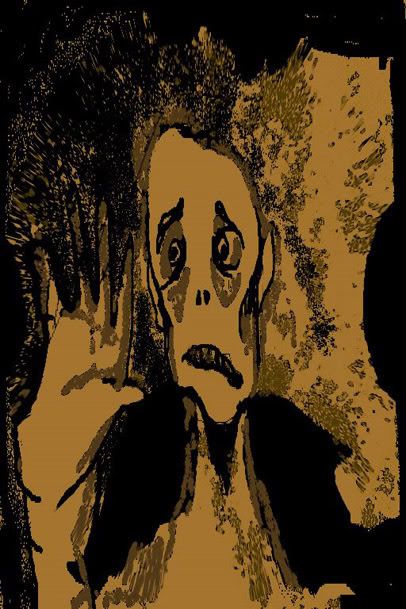
"THE SISTERS" (first story in DUBLINERS by James Joyce)
"THE SISTERS"
References:
•
http://en.wikipedia.org/wiki/The_Sisters_(short_story)•
http://findarticles.com/p/articles/mi_m2455/is_n3_v32/ai_19517919
I would like to explore once more the tantalizing mysteries of "The Sisters," assuming two of Berni's main points -- his diagnosis of the priest's madness as a crisis of faith: the priest "comes dose to losing his mind because he is seriously on the verge of losing his faith; as well as his assertion that the infirm Father Flynn "contributes to a view that the Church is both corroded and a dangerously corrosive force" (Benstock 33).
As a story about the loss of faith and the corruption of religious values, Joyce's "The Sisters" has its roots in a Georg Ebers novel of the same title. The German Ebers, an Egyptian archeologist and author of historical romances, based his fiction on historical documents. In the case of The Sisters, Ebers focused on the ancient Memphite cult of Serapis, an institution that worshiped the Egyptian and Greek equivalents of the god Osiris, a god of death and resurrection.
Joyce peppers his story with allusions to the world Ebers recaptures.(1) Joyce's references to the East include the boy's dream, the word "gnomon," and the epithet Rosicrucian. The boy dreams of "long velvet curtains and a swimming lamp of antique fashion. I felt that I had been very far away, in some land where the customs were strange -- in Persia, I thought" (13). Appropriate for a story about death, this image recalls a festival of lamps that honored the dead one night a year in a commemoration observed throughout the East. The rows of oil lamps fastened to houses were intended "to light the shades on their return to their old homes and back again to the realm of the dead" (Frazer 398).
The word "gnomon," which the boy contemplates in conjunction with "simony" and "paralysis," also points toward the East. Not only is Alexandrian Greece invoked with the naming of Euclid, but Egypt has long been considered the source of geometry -- the gnomon in particular -- as a way of measuring a loss. Herodotus tells us that any man whose property sustained damage from Nile flooding would appeal to the king, "who would send inspectors to measure the extent of the loss, in order that he might pay in future a fair proportion of the tax at which his property had been assessed." The historian surmises that "this was the way in which geometry was invented, and passed afterwards into Greece -- for knowledge of the sundial and the gnomon and the twelve divisions of the day came into Greece from Babylon" (Herodotus 169). In "The Sisters" the gnomon not only symbolizes a significant loss, in this case the loss of faith, the word signals that one dimension of Joyce's story will involve Eastern influences.
A third example of joyce's suggestive technique occurs when the uncle calls his nephew "that Rosicrucian there" (11). Members of the "Ancient Order of Rosae Crucius" believed themselves to be "mystically in touch with the Great White Brotherhood of Egypt," a priesthood that flourished in the fifteenth century BCE, recalling the cults of Memphis. This "international fraternity of religious mystics" advocated a "dreamy aesthetic withdrawal from worldly concerns" (Gifford 30). Rosicrucians, and many historians, trace the origins of early Christian asceticism to these ancient Egyptian movements.
Intrigued by an historical approach that discerns patterns repeated in different times and places, Joyce delighted in weaving together details to illustrate that ancient Eastern philosophy, religion, and politics held some meaning for modern experience. While engaged in writing and revising "The Sisters," Joyce definitely had such Irish and Eastern correspondence in mind.(2) In the 1907 lecture he delivered in Trieste, "Ireland, Island of Saints and Sages," Joyce described the Celtic language as "oriental in origin . . . identified by many philologists with the ancient language of the Phoenicians." More than the language evolved from the East, however: "The religion and civilization of this ancient people, later known by the name of Druidism, were Egyptian" (CW 156). Perhaps most indicative of Joyce's design in "The Sisters" was his pronouncement that "Ancient Ireland is dead just as ancient Egypt is dead. Its death chant has been sung, and on its gravestone has been placed the seal" (CW 173).
•
http://education.yahoo.com/homework_help/cliffsnotes/dubliners/5.html•
http://www.sparknotes.com/lit/dubliners/section1.html ----->
“The Sisters”
Summary
A young boy reflects on the impending death of his friend Father Flynn. Knowing that after three strokes the paralyzed priest has little time left, the boy makes a habit of walking past Father Flynn's house, looking for the light of the traditional two candles placed on a coffin that would indicate his death. Each time, the boy thinks of the word paralysis. One night at his aunt and uncle's house, the boy arrives at supper to find his uncle and Old Cotter, a family friend, sitting before the fire. Old Cotter has come to the house to share the news that Father Flynn is dead. Knowing that everyone waits for his reaction, the boy remains quiet.
While the aunt shuffles food to and from the table, a conversation ensues between the uncle and Old Cotter, and the uncle notes the high hopes Father Flynn had for the boy. He hints that Father Flynn planned to prepare the boy for the priesthood and remarks on the friendship between them. Old Cotter, however, thinks of Father Flynn as a “peculiar case” and insists that young boys should play with people their own age. While the uncle agrees with Old Cotter, the aunt is disturbed that anyone could think critically of Father Flynn. She asks Old Cotter to clarify his point, but Old Cotter trails off and the conversation ends. That night, Old Cotter's comments keep the boy awake, and he dreams of Father Flynn smiling and confessing something to him.
The next morning the boy visits Father Flynn's house, where a bouquet of flowers and a card hang from the door handle. Instead of knocking, he walks away and reminisces about the time he spent there. He used to bring Father Flynn snuffing tobacco from his aunt, and Father Flynn would teach him things, such as Latin pronunciation and the parts of the Mass. Remembering Old Cotter's cryptic comments, the boy then tries to recall more of his dream from the night before, but he can remember only a Persian setting—he cannot remember the end. That evening the boy visits the house with his aunt, and they kneel at Father Flynn's open coffin with one of Father Flynn's sisters, Nannie, to pray. Afterward, the three retire to another room to join Eliza, Father Flynn's other sister. Over sherry and crackers they discuss Father Flynn's death, his taxing career as a priest, and the helpful services of Father O'Rourke, another priest who anointed Father Flynn and completed all of the necessary paperwork and death notices. All the while the boy remains quiet. The story ends with Eliza's recollection of Father Flynn's increasingly odd behavior, which started with dropping a chalice during Mass. When one night Father O'Rourke and another priest found Father Flynn shut in a confessional box, laughing to himself, they finally realized he was sick.
Analysis
In “The Sisters,” and in the rest of the stories in Dubliners, strange and puzzling events occur that remain unexplained. Father Flynn suffers from paralyzing strokes and eventually dies, but his deterioration, epitomized by his laughing frenzy in a confessional box, also hints that he was mentally unstable. The reader never learns exactly what was wrong with him. Similarly, Father Flynn and the young narrator had a relationship that Old Cotter thinks was unhealthy, but that the narrator paints as spiritual when he recounts the discussions he and Father Flynn had about Church rituals. However, the narrator also has strange dreams about Father Flynn and admits to feeling uncomfortable around him. Joyce presents just enough information so that the reader suspects Father Flynn is a malevolent figure, but never enough so that the reader knows the full story. Such a technique is hinted at in the first paragraph of the story. The narrator thinks of the word paralysis when looking at Father Flynn's window and says the word sounds strange, like the word gnomon, a term that generally refers to instruments, like the hand on a sundial, that indicate something. Joyce does exactly that: He points to details and suggestions, but never completes the puzzle.
The physical presence of Father Flynn lingers throughout the story, coloring the narrator's experience of dealing with death in life and showing how a death interrupts normal human activities. Father Flynn plays a fleshly role in the story. His approaching death makes the narrator think of the corpse, which he eventually sees. When Father Flynn dies, the narrator continues to think of his physical presence, particularly the lurid way in which his tongue rested on his lip, and dreams of his face. Such bizarre physical images evoke the awkward nature of death. Like the episodes of Father Flynn's odd behavior that the sisters recount, the narrator's memories give Father Flynn a haunting presence that is fearful and mysterious, not beautiful and neat. In the final scene with the sisters, eating, drinking, and talking become difficult since death frames those activities. After viewing the corpse, the narrator declines the crackers offered because he fears that eating them would make too much noise, as if he might disturb Father Flynn in his coffin. Similarly, the narrator's aunt is unable to broach the subject of death. She asks questions about how Father Flynn died, but her thoughts trail off. Father Flynn may be dead, but in many ways he is still very present among the living.
The inability of the narrator and his aunt to eat and speak during their visit to the sisters recalls the sense of paralysis that the narrator connects to the dying Father Flynn in the story's opening paragraph. This link between paralysis or inaction to both death and religion underpins all the stories in Dubliners. Characters face events that paralyze them from taking action or fulfilling their desires, as though they experience a kind of death in life. In “The Sisters,” such paralysis is connected to religion through Father Flynn. Father Flynn's dropping of the chalice and his inability to grasp the same object in his coffin suggest that the rituals of religion lead to paralysis. His sisters also attribute his demise to the strains of clerical life. The crippling quality of religion resurfaces in other stories like “Grace,” in which Joyce more directly questions the role of the Church in the lives of Dubliners.
This story opens with an image of a Dubliner gazing through a window and reflecting on a dilemma. Such a symbol appears throughout the collection, and here it is particularly important because it draws attention to the narrative point of view. “The Sisters” is the first of three stories in the collection told in first-person point of view. As in the other two stories, “An Encounter” and “Araby,” the narrator never divulges his name and rarely participates in the conversations. The opening image of the window in the first paragraph reinforces this sense of quiet, detached observation, which the narrators of the later stories adopt. Through this narrative technique Joyce suggests that even first-hand experience is in some ways voyeuristic, and that it's possible for a person to observe his or her own life from the outside.
•
http://www.cliffsnotes.com/WileyCDA/LitNote/id-93,pageNum-53.htmlAUDIO OF THE STORY:
http://librivox.org/short-story-collection-vol-029/

















